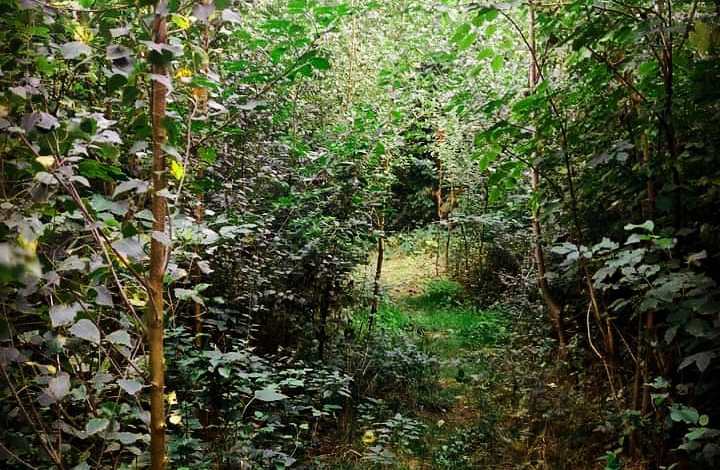A 3 year-old Miyawaki forest in Belgium. Image courtesy of Urban Forests.
Waste not, want not. That’s a motto that nature stands by. What’s waste from one part of nature serves as food for another, and so it goes in a never-ending cycle that supports, sustains, and diversifies life.
Unlike nature, most areas of our human-made economy and supply chain are linear: we begin with raw materials and then end in waste. Occasionally, we will start with post-consumer products and end in some form of recycling or reuse— though those situations are much more the exception than the rule. We can look to the practice of biomimicry to transform our economies and supply chains from linear to circular.
Forest Food Cycle
The ecosystem of a forest is a natural model for urban development. Trees and plants take sunlight, water, and earth’s minerals and turn them into food. As leaves, trees, and plants fall into the soil or are eaten by animals, fungi and bacteria break down the waste into soil that then play a role in the rise of new trees and plants. This cycle repeats over and over again, helping the forest, and all who call it home, to flourish.
Transitioning to cities powered entirely by renewable, clean energy is the start of this whole process in our built environment. We can then use this energy to create indoor urban farms that feed us with locally-grown, affordable food, while also creating jobs. Waste from our food system can then be composted and distributed back to the farms to repeat the cycle. This kind of regenerative loop, modeled on nature’s systems, keeps us healthy and protects the planet from harmful pollution caused by fossil fuel-based energy.
Natural Democracy
In addition to the economy and supply chain, science and nature also provide us with a working example for our government and business policies. Though sometimes invisible to us at the surface level, nature’s science has a method of leadership and governance that we could model for our own benefit: Life operates on the principle of ‘We, Not Me’. What matters most in nature is the community. Of course individuals have a role to play, but it is all in service to creating balance and harmony in the larger system.
Beehives and ant colonies have leadership structures, defined roles and responsibilities, and systems to maintain the hives and colonies. The motivation of each individual is to see to it that all members have what they need to be healthy and fulfill their purpose.
In the case of bees, they even vote! When a hive needs to choose a new home, scouts assess new sites, report back to the hive on the value of each location, lobby their peers, and then choose a new home based on the majority’s wishes. Our own governance systems could benefit from modeling that of bees—efficient, majority-driven, and focused on what’s best for the entire hive rather than any one individual.
Our society has tried to pave its way to prosperity with asphalt and fossil fuel. We have found that this degrades the health of the planet as it degrades the health of all beings, including us.
Rewilding Urban Spaces
In the midst of COVID-19, health is top of mind for many people. Health is always top of mind for nature. In fact, health is nature’s core tenant: Life creates conditions conducive to life. Our society has tried to pave its way to prosperity with asphalt and fossil fuel. We have found that this degrades the health of the planet as it degrades the health of all beings, including us. The solution is rewilding—restoring portions of nature that have been lost to human development and integrating them into our human-built environment.
Professor Miyawaki of Tokyo is on a mission to show the world how a major city can re-embrace its natural roots. He is creating a system of the smallest forests in Tokyo’s urban landscape, and populating them with species that once thrived on that land. These mini-forests clean the air, restore the soil, absorb excess heat, provide shade, and create a home for urban wildlife. They perform all of these services free of charge. All they ask for is a bit of land to set down roots.
To protect and conserve the natural world on which we depend, we must take our built environment’s linear systems and redirect them into a circle by modeling nature. As in nature, each piece must fit together into an integrated whole where everything has a function and role. We are not apart from nature, but rather a part of nature. By redesigning our human-crafted world to be more like nature, we secure our survival and the survival of all our kin with whom we share our planet.
 Christa Avampato is a writer and the founder of Double or Nothing Media in New York City. She is currently a graduate student in the Biomimicry Program at ASU.
Christa Avampato is a writer and the founder of Double or Nothing Media in New York City. She is currently a graduate student in the Biomimicry Program at ASU.
Twitter: @christanyc | Instagram: @christarosenyc

